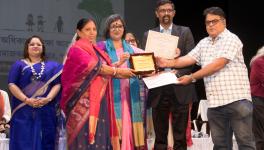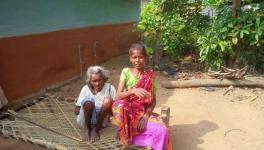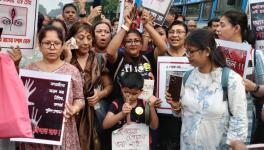Closure of Schools Under NCLP Pushes Students Back to Child Labour in Bankura, Purulia

Teacher Kousik Gupta and child labourer school student Rahul Rana making tea and serving to customers at Sotighat, Bankura. | Photos by Madhu Sudan Chatterjee
Along the state highway at Sotighat in Bankura district, one can see a tea stall with students and teachers making and serving tea to customers for nominal wages. It was seven years ago, when a child labourer school (a Special Training Centre) teacher, Kousik Gupta (52), picked up Rahul Rana (16) from a roadside sweets and tea stall and enrolled him in his school.
But, one-and-a-half years ago, child labourer schools were closed across the country on orders from the Central government. As a result, Gupta lost his teaching profession and Rana’s education came to a halt. Today, both and his student work as labourers in a tea stall to support their families.
Gupta and Rana’s case is not an isolated incident in Sotighat area on the banks of the Gadheswari River in Jungle Mahal. Such scenes are reportedly quite common in the West Bengal as well as in the country.
Teachers and education workers working with child labour are wandering without direction, suffering emotional and financial distress.
Durgadas Shit (40), a teacher in child labourer schools in Bankura, was depressed after losing his job and allegedly tried to die by suicide thrice. Six months ago, he was crushed under the wheels of a running train and died 200 feet away from his home.
What is tragic is that these boys have lost their identity as students and are once again seen as labourers.
The Central government has announced that by 2025m a child labour-free country will be built. But, can a child labour-free country be built by closing down such schools, forcing children back to doing hazardous work?
In 2001, these child labourer schools were started under the National Child Labour Project (NCLP, funded by the Union Labour Ministry. Its main objective was to save and educate children involved in hazardous work in various sectors, such brick kilns, stone quarries, mines, who were not enrolled in any school. Under the project, those aged 9-14 years were to be admitted to school in classes 1-4. In the next phase, boys and girls aged 9-14 years, who worked in tea stalls, snack centres, hotels, grocery shops, and as househelps were brought under this programme and admitted to school.
In 2014, these schools were renamed ‘Special Training Centres’. The school timings were fixed at the local level in accordance with the working hours of these newly enrolled students. Each school had a teacher, a clerk, and a peon. There was also a vocational teacher who trained students in handicrafts in two to three schools. With the sincere efforts of the teachers and staff, within a few days, the boys and girls became engrossed in their studies, and many of them even stopped working to concentrate on their studies. Even when their earnings stopped, they endured it and convinced their families to continue their studies. Some of them went ahead and took admission in local high schools. Numerous child labourer students have completed graduation and even post-graduation.
In 2019, the central government conducted a survey of these Special Training Centres. A field report was submitted by officials to Union Labour and Employment Ministry, which suggested that there was no need to run these child labourer schools separately. Thereafter, on March 14, 2022, the Ministry issued a directive in this regard, stating the Special Training Centres had been closed down, and its students should be admitted to the nearest government-sponsored primary and high schools by March 31.
It is said that this was done keeping in mind the New Education Policy, which was implemented in 2020. With this order, 7,300 such schools across the country were closed, and about 32,000 teachers and workers lost their jobs. Nearly 25,000 poor women who were involved in cooking mid-day meals in these schools became unemployed, as per reports. The education of about four lakh students became uncertain.

Child labour school teachers and workers protesting in front of Bankura district magistrate office for payment salary dues.
Shekh Firoj, Secretary of the All India and West Bengal Staff Association of the National Child Labour Project, told this reporter, "At the time of closure, 619 child labourer schools were running in West Bengal. There were 3,000 teachers and workers and around 30,000 students across the state. According to him, Bankura, Purulia, and Birbhum districts had more schools within Bengal.
Firoj alleged that in one blow, the Central government took away the means of survival of the teachers and workers of this project. In most places, teachers and workers have not even received salaries for 36-48 months, and the stipend that students used to get at Rs 400 per month has also been stopped for five years now.
“After the closure of these schools, we repeatedly went to the Ministry of Labour in New Delhi to highlight the painful conditions of the teachers and workers. A few days ago, on behalf of the organisation, we met Union Education Minister Dharmendra Pradhan and Labour Minister Bhupendra Yadav and demanded that our overdue salaries be paid and re-employment be arranged. But, we realised that no one wants to take any responsibility,” he said.
Firoj said both the Central ministers (Labour and Education) informed them that the state government would make all arrangements.
“After we reported the matter to the West Bengal state secretariat, Nabanna, the state officials concerned told us that it is the Central government's responsibility, and they will take care of our demands,” he added.
Child Labour School Students, Teachers Left in Lurch
In Jungle Mahal Jangal’s Bankura and Purulia districts there were more such child labour schools as the region houses very poor families. Several children in these areas were working in brick kilns, stone quarries, sand collection and sales in tea and sweets shops, hotels, etc. Some were enrolled in primary schools but did not attend.
Sudip Sen, a teacher in one such school in at Bhataspur village under Saltora Block, Bankura, and also the secretary of the Staff Association of the National Child Labour Project, told this reporter, "We made a lot of effort to motivate the children who worked in stone crushers, brick kilns, local tea and sweets shops, or even begged at bus stands, to study.
Mohd Mustak Shah, a teacher in Mukundapur village under the Joypur Block and secretary of the Staff Association NCLP Purulia District, said, "We also motivated their parents, which was not easy at all. They repeatedly said that if their children are engaged in education, when will they work? Keeping these conditions in mind, we used to conduct schools early in the morning or late in the evening."
Kousik Gupta said he had to make several attempts to convince Rana’s parents to get him enrolled in a child labourer school.
There were 56 such schools in Bankura and 49 in Purulia district, with over 5,000 boy and girl students and above 600 teachers, vocational teachers, and staff. No separate housing infrastructure for child labour schools was provided by the government. Hence, these were run in village primary schools, ICDS (Integrated Child Development Scheme) centres, and local temples.
While serving tea to customers, Rana told this reporter that he was admitted to class 1 at the age of 10. “Our teacher taught with care. Seeing my interest in studies, my parents forbade me to work in the tea stall. I entered Bikna High School in class 5. The school was closed during the COVID pandemic. I forgot all my studies and stopped going to school. Now I am working here” he said.
Rana said after the closure of the school, seeing the condition of "Sir" (Kousik Gupta), he called him to work in this tea stall to support his family. Teacher Gupta, a resident of Bankisantra village of Bankura, said, "My family had no other income. I used to get a monthly salary of Rs. 7,000 from this school, but I did not get paid every month. I often received it after 8-10 months. But still, I had a job. Now everything has stopped. I have not received salary for 36 months. What can I do in this situation? I was forced to work at the tea stall to feed my family. I make Rs 5,000 a month from this tea stall."
Sudip Sen and Mustak Shah said teachers used to get Rs. 7,000, clerks Rs. 5,000, peons Rs. 3,000, and vocational teachers got Rs. 9,000/month. They said Bankura's teachers and staff have also not received salaries for 36 months. The students have not got stipend for five years. In Purulia District, there is no salary due for teachers and staff, but the students' stipend remains unpaid for five years. Teachers and staff are literally left with no direction after the school closures.
Teachers Chiranjit Garai in Bankura, Santosh Murmu, Protima Sahi, Ashoke Mahato, who worked in child labourer schools in Bandowan, Purulia, told this reporter, "Our working age has passed, we will not find work anywhere else. How will we survive? Several teachers and workers in the two districts are selling vegetables, toys and various cheap clothes on pavements, while some are trying to find security guard jobs.”
The condition of students is worse. Teacher Parimal Mahato of Ranibandh, Shila Kundu of Bankura, Jayanto Sardar of Manbazar 2, Tapan Adhikari of Purulia, said after the Central government’s order, we admitted boys and girls to local primary and secondary schools, but they are not going to school anymore.
They said since child labourschools were closed due to the COVID pandemic from 2020 to 2022, the students were already behind in their studies, and did not want to go to a new school.
Ashis Chatterjee, headmaster of Bankura Bigna High School, Madan Ghose, a teacher in charge of Ranibandh Purnapani School, Debapratim Banerjee, teacher of Joypur High School in Purulia, said most of the students who were admitted from child labour schools do not attend school, and no initiatives have been taken to bring them back to school. Govinda Bauri, a former child labour student, told this reporter, "I have no friends in the new school; all of them are much younger, and I cannot study with them. So, I left my studies and joined as a construction worker.”

After closure of child labour schools, Gobinda Bauri a student in Indpur, Bankura, is now working as a construction worker.
The biggest problem is in primary schools. Sukumar Hansda, the father of Chhoton Hansda in Bhataspur, said his son was 12 years old when he was admitted to class 3. Boys younger than him are studying in that class in the government primary school. He does not want to go to school. So, he now grazes cows in the field.
Several girl students, like Soma Bauri (16) in Saphagara village, Bankura, have got married. Most students have rejoined the workforceor have left the state as migrant workers.

Teacher Kousik Gupta with Saraswati, Rinku and Soma Bauri. Rinku Bauri and Saraswati Bauri have quit their studies; Soma Bauri has married after the closure of their school.
When asked, the officer in charge of Special Training Centres and Additional District Magistrate Bankura (General), Proloy Ray Choudhury, told this reporter that they had informed Delhi many times, through Nabanna, that teachers and workers of child labour schools should get their due salaries, and efforts should be made to bring back these students to school.
While a response from the Centre and state is still awaiting, the child labour students and teachers continue to struggle to eke out a living in these trying times.
The writer covers the Jungle Mahal region for ‘Ganashakti’ newspaper in West Bengal.
Get the latest reports & analysis with people's perspective on Protests, movements & deep analytical videos, discussions of the current affairs in your Telegram app. Subscribe to NewsClick's Telegram channel & get Real-Time updates on stories, as they get published on our website.
























